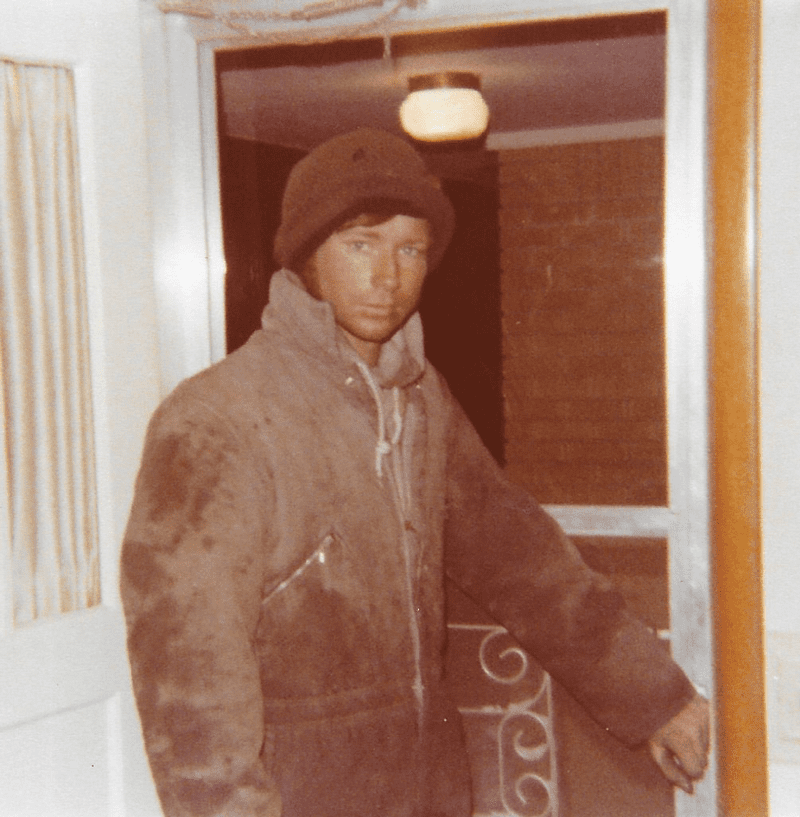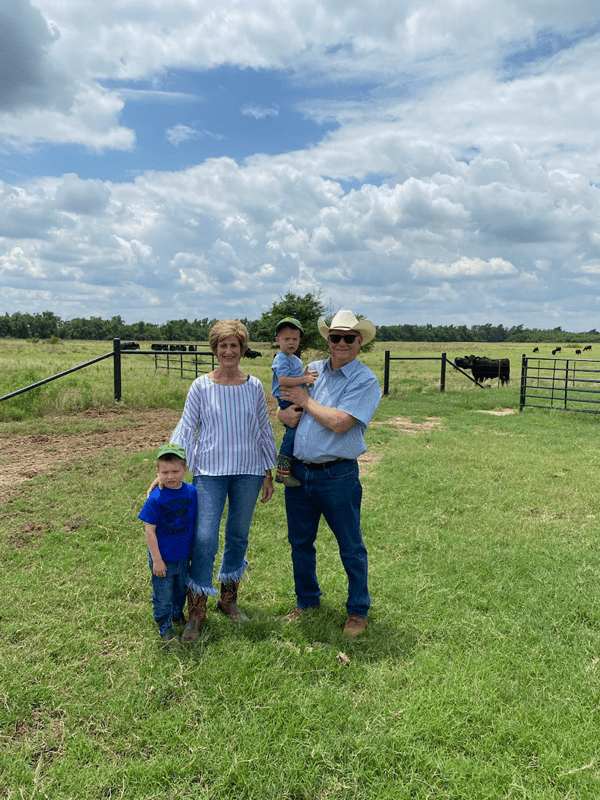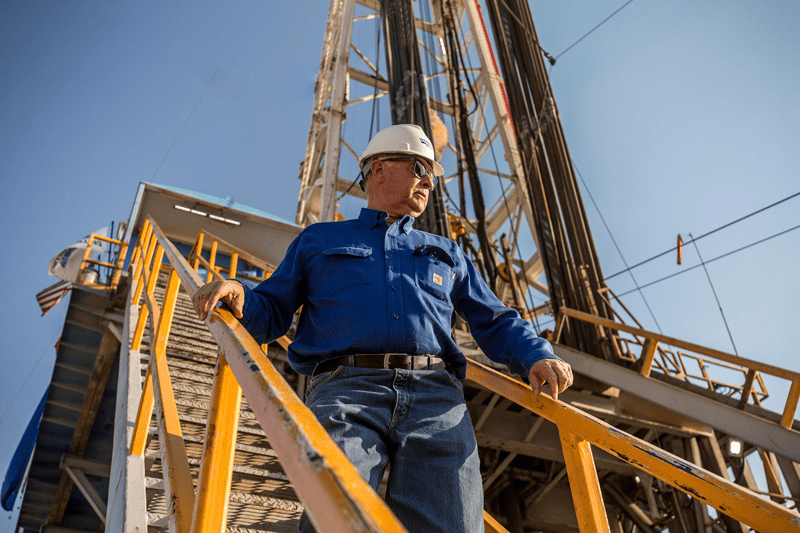Rick Muncrief, the CEO of Devon Energy, is no stranger to stock market pundit Jim Cramer’s CNBC show, Mad Money, having appeared numerous times to offer his insights on the energy industry, specifically as it pertains to the oil and gas sector. Most recently, Muncrief appeared on the August 7th episode, responding to Cramer’s rapid fire questions in his slow, steady baritone, providing facts and figures to support his commentary on the state of the industry. While the two men seemingly couldn’t be more different in personality and demeanor, they are, in fact, friendly in real life.
“I’ve known Jim for a number of years,” Muncrief says, reminiscing about hosting Cramer in 2010 or so, when Muncrief was working with Harold Hamm at Continental Resources, and they filmed a live episode of Mad Money in the field in North Dakota in the early days of the Bakken.
“He wanted some time after we finished the live interview the other day,” Muncrief says during our conversation a week later. “We took a couple of minutes offline and talked about trying to plan a trip back. I told Jim we’re not getting any younger, so I’d love to take him to see the Williston Basin today versus the early days, when we were producing about 300,000 barrels of oil per day.1 I told him then that it was just a matter of time before North Dakota passed Alaska in production. He was incredulous how that could possibly happen. And I think North Dakota is probably producing three times what Alaska is now, so it’s just been a phenomenal ride in this industry.”
Historical Changes
When you have been in the oil and gas industry as long as Rick Muncrief has, you have been part of history in the making. “I have been so blessed in my career to see the evolution of technology on a lot of fronts.” Starting in 1980 when he began his career as a petroleum engineer, Muncrief says he can put the most exciting developments he has witnessed over the last 44 years into four “buckets.”
He categorizes horizontal drilling as the biggest change having revolutionized the way oil is discovered and captured. The second is the development of downhole tools and downhole capability development over and above just the drilling.

He cites the successful lifting of the 2015 ban on crude oil exports, which enabled the flow of crude oil into the global markets, helped keep prices in check and allowed the U.S. to grow, as the third development, and something he calls “a win for industry, a win for the economy, a win for energy security.” Noting that U.S. production is over 13 million barrels of oil a day now, Muncrief says, “That’s more than any country, at any time in history, has ever produced and we would not have been able to do that had we not been able to successfully get the ban lifted.”
The fourth major development is the data capabilities available to the industry now, with Muncrief pointing out the “incredible amount” of data the sector itself consumes – from lease agreements all the way up to drilling, completions and production, tracking a wide variety of metrics for everything the company does, including exploration and reservoir characterization, enabling a greater understanding of incredibly complex reservoirs.
Although he has managed to neatly sum up those four historical developments, Muncrief says, “We could be here all day talking about the technological advancements that have driven us for the betterment of mankind and the betterment of economies around the world.”

Growing Up in the Field
Today’s technology-driven energy industry is a far cry from the Texas and Oklahoma oil fields where Muncrief grew up in the ‘60s and ‘70s, watching his father and grandfather work and listening to their stories.
He recalls his granddad talking about working on a pulling unit in southern Oklahoma for a short time before he got a job with the state of Oklahoma “as a maintenance man, if you will, so I’ve just kind of grown up around this business.”
His dad worked on plant and pipeline construction and often would take Muncrief into the field with him on weekends. It was there Muncrief had the opportunity to experience first-hand the different areas of the industry – heavy machinery and large engines, drilling and workover rigs, gas plants – in addition to observing pipelines being constructed.
“That’s what really impressed me as a youngster and made me want to go into engineering and, specifically, the energy space.”
Muncrief wasted no time. At 17, his parents signed a minor’s release, which allowed him to work on a pipe inspection crew, although he would have to wait until he turned 18 to work on a drilling rig.
“Over the next several years, that’s what I did on the summers and spring breaks and all the holidays – Thanksgiving, Christmas holidays and breaks, summer vacation – and that’s how I paid for my college education,” says Muncrief, who majored in petroleum engineering technology, and graduated from Oklahoma State University (’80) with a Bachelor of Science.
“I was very fortunate that I got exposed to this wonderful industry at a young age and I’ve been working ever since, so I never ever looked for a job.”

The ‘80s: “A Troubling Decade”
Despite never having to seek alternative employment, Muncrief entered the industry in 1980, which he calls “a troubling decade,” not just for the energy industry, but the world economy as a whole. Not surprisingly, this meant the oil and gas sector would go through a boom and bust cycle.
The Natural Gas Policy Act (NGPA) of 1978 opened up new areas for exploration and production, and Muncrief says government incentives “basically deregulated gas.” He recalls natural gas being discovered below 15,000 feet in the Anadarko Basin in western Oklahoma, which resulted in an increase in the drilling of deep gas wells, and refers to that period as “a fascinating time” in the industry.
While the start of the decade saw a lot of activity, Muncrief points out it was also a time of high inflation and lingering concerns over America’s oil and gas supply. By the mid-80s, the industry was in a downturn, with massive layoffs and loss of talent, along with inflation and a decade-defining financial crisis. The energy sector was hard hit, as were the financial and banking sectors, resulting in the widespread failure of savings and loan institutions in the late ‘80s and early ‘90s.
“That was probably my first true, as I say, “indoctrination” into how fast things can change.”

Game Changer
Despite the economic upheaval, the industry soldiered on – and Muncrief right along with it, marveling at the breakthroughs that were made during such an extraordinarily difficult time. He had moved to Billings, Montana, in 1984 and, three short years later, his team drilled some of the very first horizontal Bakken wells, including a 2,000 foot lateral.
“That’s 37 years ago,” Muncrief points out. “It’s just amazing what we had to do in those days – and we were successful. The main difference is, we were just chasing natural fractures; we weren’t even stimulating or putting frack jobs on the well. We simply didn’t have the downhole technologies. The technological advancements have been one of the things that really changed the game.”
Generational Knowledge
While technology was transforming the industry, Muncrief was being influenced by the people he met along the way. As a young drilling engineer at El Paso Exploration, his first supervisor was an “awesome, but really tough guy to work for,” and Muncrief is appreciative of the lessons he learned during that time.
He credits Don Clayton, then the chief operating officer of Meridian Oil (later Burlington Resources) and eventually the CEO, as being an early mentor, and, of course, Harold Hamm, CEO of Continental Resources. “I worked with Harold for five years and it was a different kind of learning. Primarily, it was more big picture and strategic in nature.”
It was those men, as well as his father and grandfather, and others along the way who inspired him to make a concerted effort to mentor those around him – “the younger folks especially.” Muncrief has concerns about the world we live in today, with remote work from home (WFH) models, and Zoom conference calls.
“Maybe I’m a little bit old fashioned or old school, but I do worry about passing on all the knowledge that people have. It’s not just successes, but a lot of what we learn is from failures and people don’t talk about it as much. Knowing what didn’t work, as much as what did, is extremely important.”

Energy: A Family Tradition
It’s apparent Muncrief has been an exemplary role model and mentor within his own family, as both his son and daughter were inspired to join the industry. His son Grant is a drilling and completions manager at another large independent, and his daughter Mindy (currently on sabbatical) has had a 14 year career in the industry, starting in international drilling and completions, working offshore in West Africa, spanning roles across the spectrum of the sector, and eventually working in low carbon ventures.
“This is not just my career,” Muncrief emphasizes, who has been married to wife, Gail, for 44 years. “It’s our career and our story as a family and as a team here at the company, but I do try to share a lot of my stories and any kind of knowledge I may have. I love to do that.”
With four grandchildren, including two new granddaughters under the age of one, the proud grandfather may be leading the way for another generation to carry on the Muncrief family tradition of working in the energy industry.

The Era of Mergers and Acquisitions
It began with a merger and it continues with a merger. After a seven year tenure as CEO of WPX, Muncrief joined Devon Energy as president and CEO when the two companies merged in 2021. Devon, an independent exploration and production company, operates in five basins: the Williston, Powder River, Anadarko, Delaware and Eagle Ford, and now controls over 1.5 million net acres.
This past July, Devon acquired Grayson Mills Energy’s Williston Basin assets located mainly in western North Dakota. It was the right decision for Devon because “it’s oil weighted,” says Muncrief. “Our outlook is that oil is going to drive margins for quite some time,” given that the price of natural gas is depressed.
Muncrief is enthusiastic about the acquisition because it comes with a solid level of base production that doesn’t have a steep decline curve. Devon intends to drill 500 new wells on the acreage with another 300 wells that are potential candidates for restimulation (“refracking”). The Grayson Mills merger gave Devon an additional 300,000 net acres in the Bakken, something Muncrief calls “a large playground to look for future potential.”
“That’s our mantra: Stay as oily as we can for as long as we can.”
An All-Inclusive Energy Industry
After seeing the pendulum swing away from oil and gas in favor of renewable energies, the momentum seems to have righted itself with many high-level executives and decision makers across the various sectors of the energy industry agreeing that it will take all forms of energy to supply the world’s needs.
“Realistically, this world has to have energy, and oil and natural gas are a huge part of that,” states Muncrief decisively. “We’ve utilized technology and some other creative approaches to the industry and it’s been game changing, but what has not changed is the fact that demand for oil and natural gas has continued to go up worldwide.”
Muncrief believes that trend will continue for many years, as well as the amount of work that has to be done just to keep production flat and offset the natural decline curves. “It’s just stunning how much work it takes,” says Muncrief, who certainly knows from decades of experience, “so I still think there’ll be a lot of opportunities in the energy business.”

Bringing STEM to the Permian
In turn, the energy industry has given Muncrief, his family, and the company he helms, the opportunity to give back. Under the banner of contributing in a tangible way to the communities in which Devon has a presence, the company has partnered with the Cal Ripken Foundation on STEM initiatives and, to date, has put in more than 160 STEM centers in elementary schools across the five states in which Devon operates. Currently, in collaboration with the Permian Strategic Partnership, a group of over 30 companies, the ultimate goal is to put STEM centers in every elementary school in the Permian Basin on both the Texas and New Mexico sides.
“Cal Ripken, Jr., and Bill Ripken have a great team. They do a lot for sports and education and health, but the one thing that really resonated with the Devon team is STEM education,” says Muncrief. “We’ve got a lot of challenges in this world and they understand the need for bright minds.”
Working with the Ripken Foundation is an example of just one of the many things Devon does, in Muncrief’s words, “to try to make this a better world.”
A Winning Combination
Their August 7th Mad Money conversation led Jim Cramer to list Devon Energy among his “Top 10 Things to Watch,” on August 8th, asking rhetorically, “Is Devon Energy the next major independent oil company?” He says he thinks it is and adds, “Muncrief has put together a winner.”
Headline photo: Rick Muncrief on location in the Permian Basin. Photos courtesy of Rick Muncrief.
1 – According to the North Dakota Pipeline Authority, in June 2024, the most recent date for which data is available, oil production for the Williston Basin was 1,175,567 bopd.
Mark A. Stansberry, energy advisor and corporate development strategist, has been a columnist and contributor for Energies Media since 2014. He is the author of America Needs America’s Energy: Creating Together the People’s Energy Plan and the host of the National Energy Talk podcast. Stansberry served as U.S. Senator Bartlett’s intern/staff member from 1975-76, and led Senators Bellmon and Bartlett’s State Youth Conference in 1976. Stansberry can be contacted through his website.
Rebecca Ponton is the editor in chief at U.S. Energy Media and author of Breaking the Gas Ceiling: Women in the Offshore Oil and Gas Industry. She is the publisher of Books & Recovery digital magazine.







